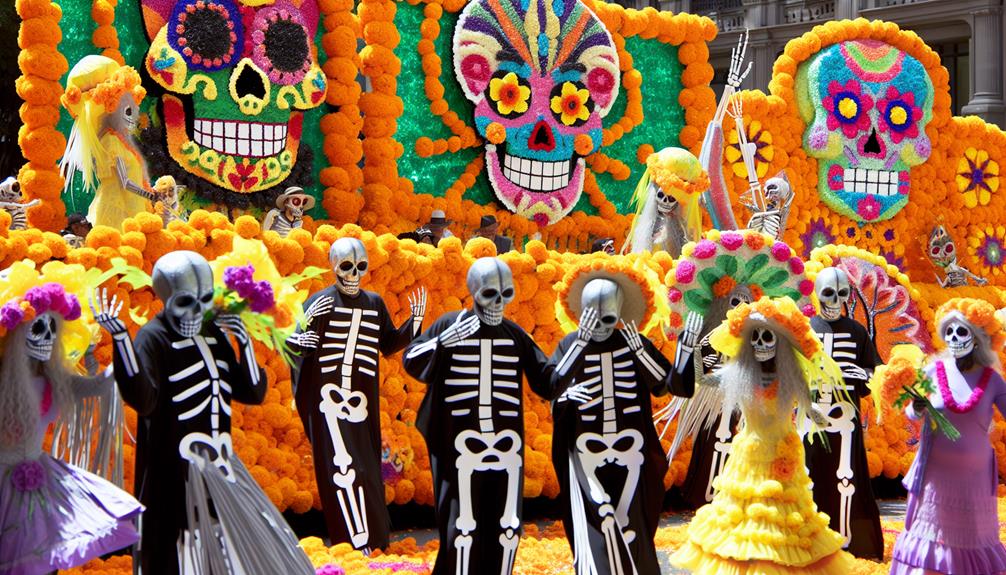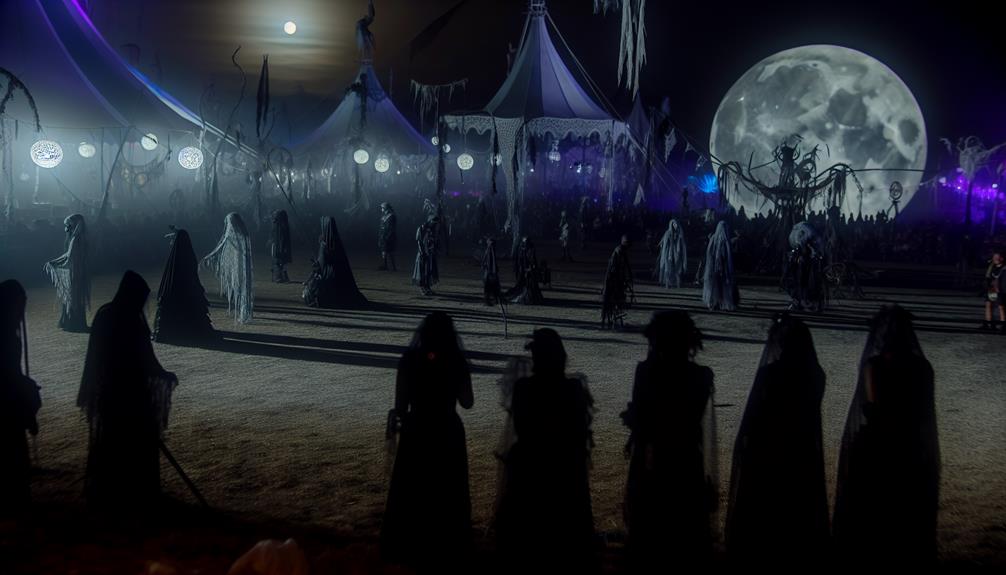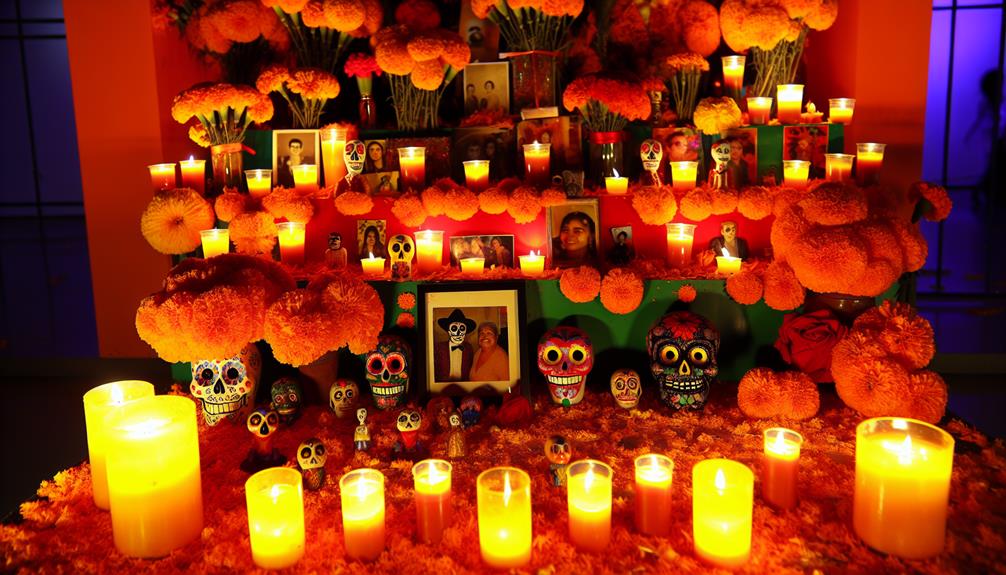The Festival of the Dead in the USA brings to life a tapestry of cultural traditions and rituals that captivate attendees with its vibrant displays and rich symbolism. This event, steeped in ancient practices and modern interpretations, offers a unique opportunity to explore the intersection of heritage, creativity, and spirituality. As participants engage in honoring their ancestors and immersing themselves in communal festivities, the festival serves as a bridge between the past and the present, inviting individuals to discover the profound connections that bind us to our roots and to each other.
Key Takeaways
- Festival of the Dead in the USA blends Mesoamerican and Mexican traditions.
- Symbols like skulls and marigold flowers represent death and rebirth.
- Elaborate altars with photos, candles, and favorite foods honor the departed.
- Festive parades feature vibrant costumes, music, and decorations.
- Community involvement, workshops, and culinary delights enrich the festival experience.
History of the Festival
The Festival of the Dead in the USA is a testament to the blend of cultural traditions and historical practices that have evolved over time. This festival, also known as Día de los Muertos, has its roots in ancient Mesoamerican rituals honoring deceased ancestors. The Aztecs and other pre-Columbian civilizations celebrated death as a natural part of the human experience. When the Spanish conquistadors arrived in the Americas, they attempted to Christianize these indigenous practices, leading to the syncretism that characterizes the modern Festival of the Dead.
Over the centuries, the celebration has continued to evolve, incorporating elements from various cultures and belief systems. In the United States, this evolution has been shaped by the contributions of Mexican immigrants who have preserved and shared their traditions with the wider community. As a result, the Festival of the Dead in the USA has become a rich tapestry of customs, blending indigenous, European, and African influences.
The festival's evolution reflects the dynamic nature of American society, where diverse cultural practices coexist and interact. It serves as a poignant reminder of the interconnectedness of different traditions and the ways in which they can merge and transform over time. The history of the Festival of the Dead in the USA is a testament to the enduring power of ancestral veneration and the resilience of cultural heritage in the face of change.
Cultural Traditions and Symbols
Reflecting a blend of diverse cultural influences, the Festival of the Dead in the USA showcases a myriad of unique cultural traditions and symbols. The celebration draws inspiration from various sources, with a significant influence from Mexico's famous Day of the Dead festivities.
- Day of the Dead, Mexico, influence: The Mexican Day of the Dead, known for honoring deceased loved ones, has heavily influenced the way the Festival of the Dead is celebrated in the United States. The vibrant colors, elaborate altars, and festive atmosphere pay homage to this rich tradition.
- Skull symbolism: Skulls hold a prominent place in the Festival of the Dead, symbolizing death and rebirth. These skulls, often intricately decorated with colorful designs, are seen as a way to remember and celebrate the lives of those who have passed.
- Colorful decorations: Brightly colored decorations are a hallmark of the Festival of the Dead in the USA. From marigold flowers to papel picado banners, the use of vivid hues adds to the lively and celebratory nature of the event.
- Altars and offerings: Building altars adorned with photographs, candles, incense, and the favorite foods of the departed is a common practice during the Festival of the Dead. These offerings are believed to guide the spirits of the deceased back to the world of the living for a brief visit.
Festive Parades and Processions
Drawing inspiration from colorful cultural traditions, the festive parades and processions during the Festival of the Dead in the USA captivate participants with their vibrant displays and symbolic significance. Costume creativity takes center stage as participants don elaborate outfits representing various themes like skeletons, ghosts, and mythical creatures. The streets come alive with a kaleidoscope of colors and textures, showcasing the creativity and attention to detail that goes into each costume.
Crowd enthusiasm fuels the energy of these parades, with spectators lining the streets to cheer on the participants. The festive atmosphere is further enhanced by street decorations that adorn the parade route, creating a visually stunning backdrop for the procession. Vibrant banners, colorful lights, and intricate displays contribute to the overall ambiance of the event, immersing both participants and onlookers in a celebration of life and remembrance.
As the parade winds its way through the city, the rhythmic beats of drums and lively music fill the air, adding to the sensory experience. The procession serves not only as a form of entertainment but also as a way to honor the traditions and customs associated with the Festival of the Dead. Through costume creativity, crowd enthusiasm, street decorations, and a vibrant atmosphere, the parades and processions play a crucial role in bringing communities together to celebrate and remember loved ones.
Intricate Altars and Offerings
In celebrations of the Festival of the Dead in the USA, intricate altars and offerings play a significant role in honoring and remembering departed loved ones. These elaborate designs hold deep spiritual significance, creating a sacred space for remembrance and connection with the spiritual domain.
- Elaborate Altar Designs: Participants construct altars adorned with vibrant flowers, candles, and personal mementos of the deceased. These altars are meticulously arranged to create a visually stunning display that reflects the unique personality and life of the departed.
- Symbolic Offerings: Offerings such as favorite foods, drinks, and other cherished items are placed on the altars as a way to nourish and honor the spirits of the dead. These offerings are believed to provide comfort and sustenance to the departed as they journey into the afterlife.
- Cultural Diversity: Different cultural influences are reflected in the design and offerings of the altars, showcasing the rich tapestry of traditions that make up the Festival of the Dead in the USA. This diversity adds depth and meaning to the event, highlighting the universal themes of love, loss, and remembrance.
- Emotional Connection: The act of creating these altars and offerings fosters a deep emotional connection between the living and the dead, allowing participants to express their grief, love, and respect in a tangible and meaningful way. This process of honoring the departed through intricate altars and offerings serves as a powerful form of catharsis and healing for those left behind.
Musical Performances and Entertainment
Music and entertainment at the Festival of the Dead in the USA add a dynamic element to the commemoration of departed loved ones. Live performances play a significant role in creating a vibrant atmosphere that honors the spirits of the deceased. These performances often feature a diverse range of musical genres, from traditional tunes to contemporary sounds, catering to a wide audience with varying tastes. Attendees are immersed in an array of interactive experiences, such as participatory drum circles, dance sessions, and storytelling performances that engage them on a deeper level with the theme of remembrance.
The Festival of the Dead offers a platform for both established artists and emerging talents to showcase their creative expressions. This blend of experienced performers and fresh voices contributes to the festival's rich tapestry of entertainment, ensuring there is something for everyone to enjoy. The live music acts not only entertain but also serve as a means of connecting people through shared cultural experiences and emotional resonance.
In addition to musical performances, interactive experiences like art installations, theatrical presentations, and themed workshops further enhance the festival's entertainment offerings. These activities encourage active participation from attendees, fostering a sense of community and togetherness as they collectively celebrate the memories of those who have passed on. The Festival of the Dead in the USA stands out as a unique event that combines artistic expression with commemoration, creating a memorable and engaging experience for all who partake in its festivities.
Culinary Delights and Treats
The diverse array of culinary delights and treats available at the Festival of the Dead in the USA caters to a wide range of palates, adding a flavorful dimension to the commemorative event. Attendees can indulge in a variety of sweet delicacies and savory treats that are sure to satisfy their taste buds. The culinary creations at the festival are a celebration of festive flavors that honor the spirit of the occasion.
- Sugar Skull Cookies: These intricately decorated cookies are not only visually appealing but also a delicious sweet treat that pays homage to the traditional sugar skulls associated with the Day of the Dead.
- Spicy Pumpkin Empanadas: Combining the richness of pumpkin with a kick of spice, these savory empanadas are a popular choice among festival-goers looking for a flavorful snack.
- Pan de Muerto: A traditional Mexican sweet bread, Pan de Muerto is a must-try at the festival. Its unique flavor and symbolic decorations make it a standout culinary delight.
- Chili Chocolate Truffles: Blending the heat of chili with the sweetness of chocolate, these truffles offer a unique taste experience that captures the essence of the Festival of the Dead.
These culinary offerings not only provide sustenance but also serve as a culinary tribute to the rich traditions and cultural significance of the event.
Community Involvement and Participation
Facilitating active engagement and collaboration within the community enhances the depth and authenticity of the Festival of the Dead in the USA. Volunteer opportunities play a pivotal role in fostering a sense of ownership and belonging among participants. By involving volunteers in various aspects of the festival, from planning to execution, the event becomes a collective effort that reflects the diverse interests and talents within the community. Workshops further enrich the experience by providing opportunities for skill-sharing and creative expression.
Interactive activities and art installations serve as focal points for community involvement during the Festival of the Dead. These elements not only engage attendees but also encourage them to actively participate in the celebration. Interactive activities like mask-making workshops or community altar-building sessions invite individuals to contribute their creativity and personal stories to the event. Art installations, whether temporary or permanent, create a lasting impact that resonates with the community long after the festival ends.
Frequently Asked Questions
Are Pets Allowed to Participate in the Festival of the Dead?
When considering the participation of pets in events like the Festival of the Dead, pet costumes are a common way to involve animals in the festivities.
Additionally, some cultures incorporate animal blessings as part of their rituals, highlighting the significance of pets in such celebrations.
While specific guidelines may vary, allowing pets to participate can enhance the overall experience for attendees and create a sense of inclusivity within the event.
Is There a Dress Code for Attendees of the Festival?
When attending events that hold cultural significance, such as the Festival of the Dead, it is common to adhere to a specific dress code. Costume options play an essential role in reflecting the spirit and essence of the occasion.
Embracing traditional attire or themes can enhance the overall experience and connection to the event's roots. Understanding the importance of dress codes in such settings can deepen one's appreciation for the cultural significance of the celebration.
Are There Any Age Restrictions for Participating in the Festival?
Age restrictions for participation in events are common to guarantee safety and appropriateness for all attendees. Guidelines may vary, with some events being family-friendly and open to all ages, while others may have restrictions due to the nature of the activities or themes involved.
It is advisable to check the specific event's policies regarding age restrictions before attending to guarantee compliance and an enjoyable experience for all participants.
Can Attendees Bring Their Own Offerings to the Altars?
Attendee participation at altars can vary greatly. Some events allow attendees to bring their own offerings, akin to adding personal touches to a blank canvas.
However, it is crucial to confirm specific guidelines with event organizers to make sure that any items brought align with the overall theme and purpose of the altar decorations. This practice helps maintain the integrity of the event while allowing participants to engage in a meaningful way.
Is Photography and Videography Allowed During the Festival?
Photography and videography policies at cultural events often balance artistic expressions with cultural boundaries. Ethical considerations, like respecting sacred rituals, may restrict capturing certain moments.
Social media sharing adds complexities, requiring sensitivity to participants' privacy and consent. Comparatively, some events encourage documentation to promote cultural understanding, while others prioritize in-the-moment experiences.
Attendees should familiarize themselves with guidelines to navigate these nuances respectfully and responsibly.
Conclusion
To sum up, the Festival of the Dead in the USA serves as a powerful symbol of cultural heritage, community unity, and spiritual reverence.
Through its diverse traditions and vibrant celebrations, the festival showcases the interconnectedness of past and present, life and death.
It is a reminder of the importance of honoring our ancestors, preserving traditions, and embracing the cycle of life with respect and gratitude.
This event truly embodies the richness and depth of cultural expression within the American landscape.


